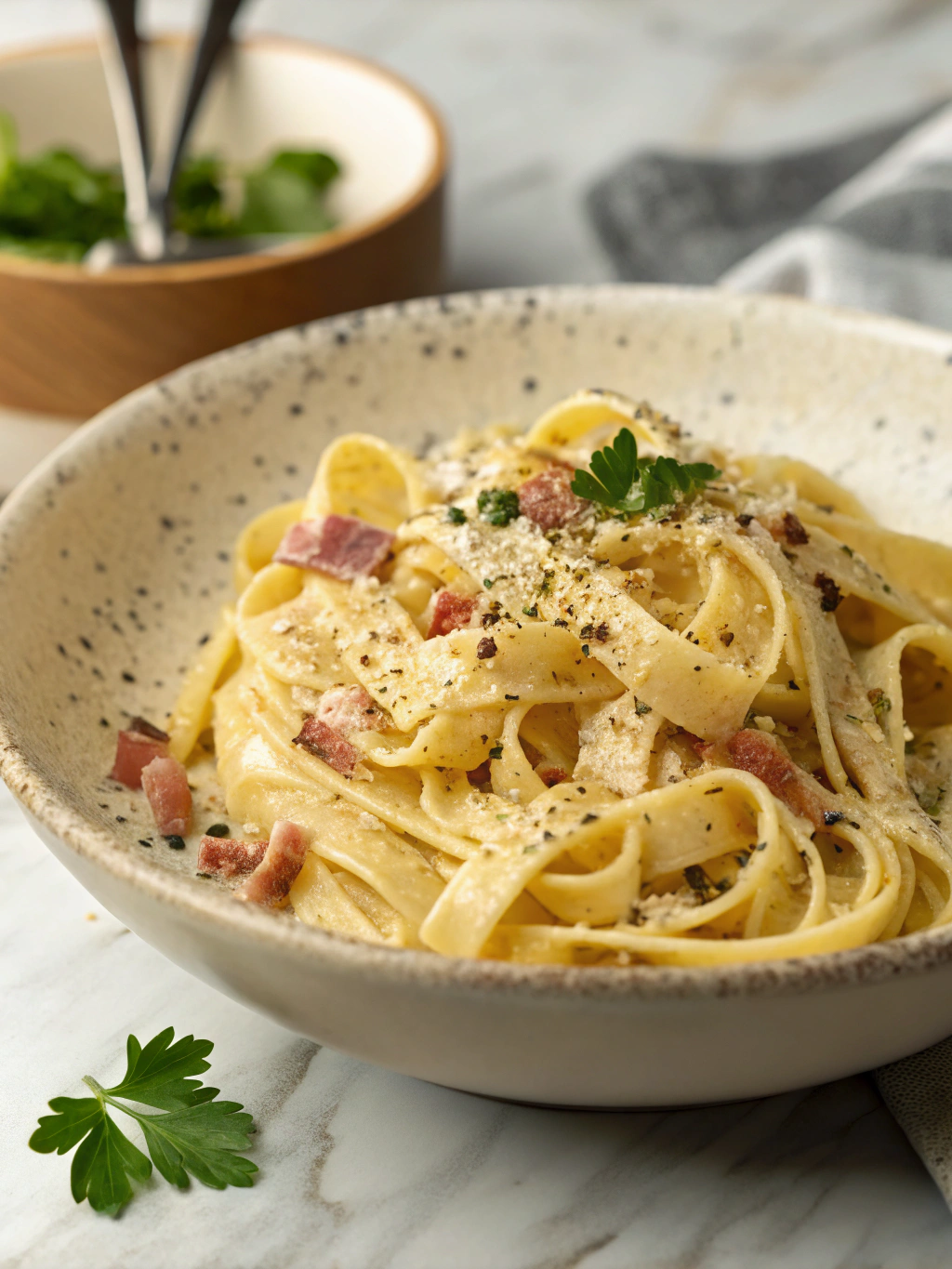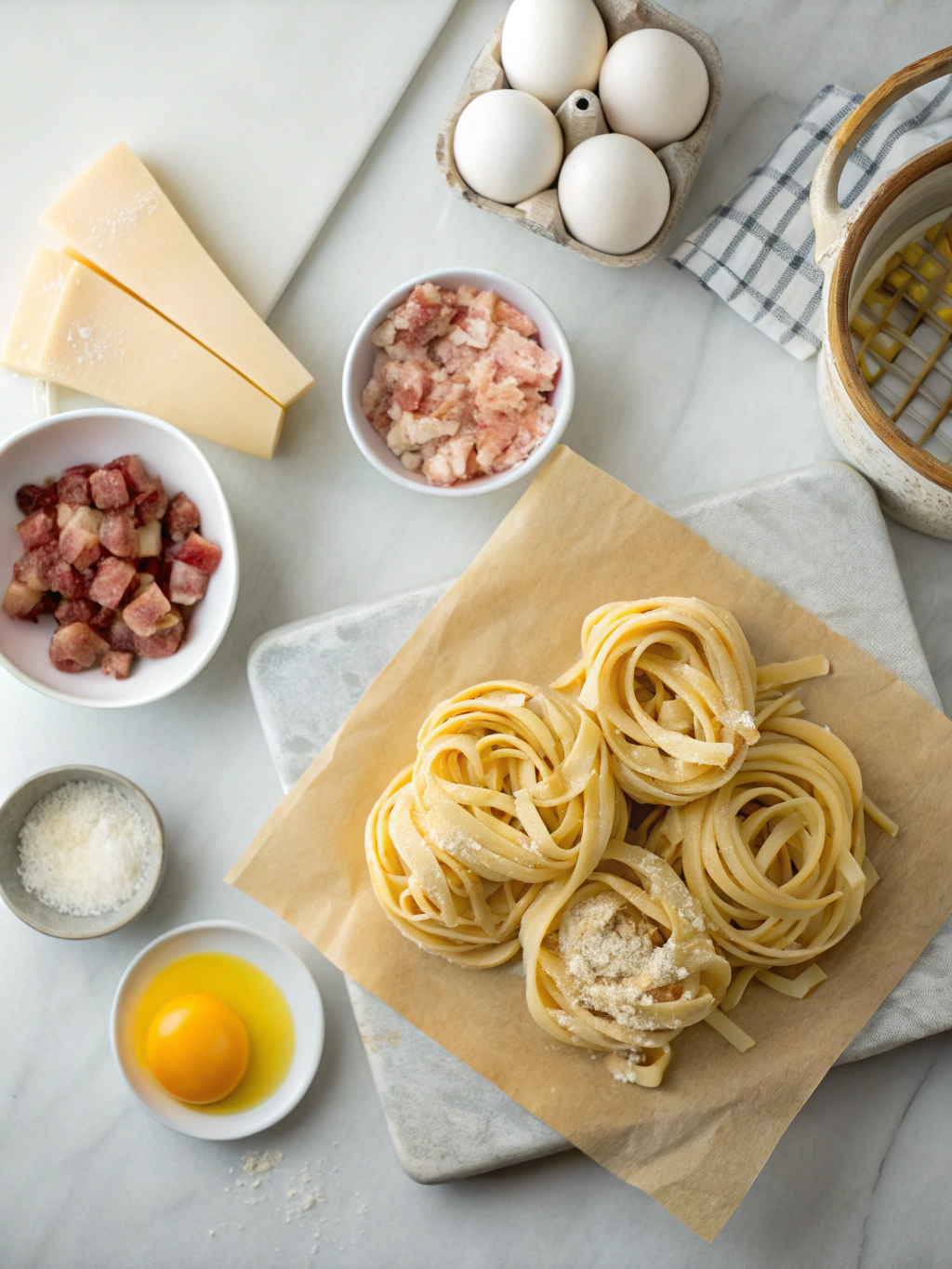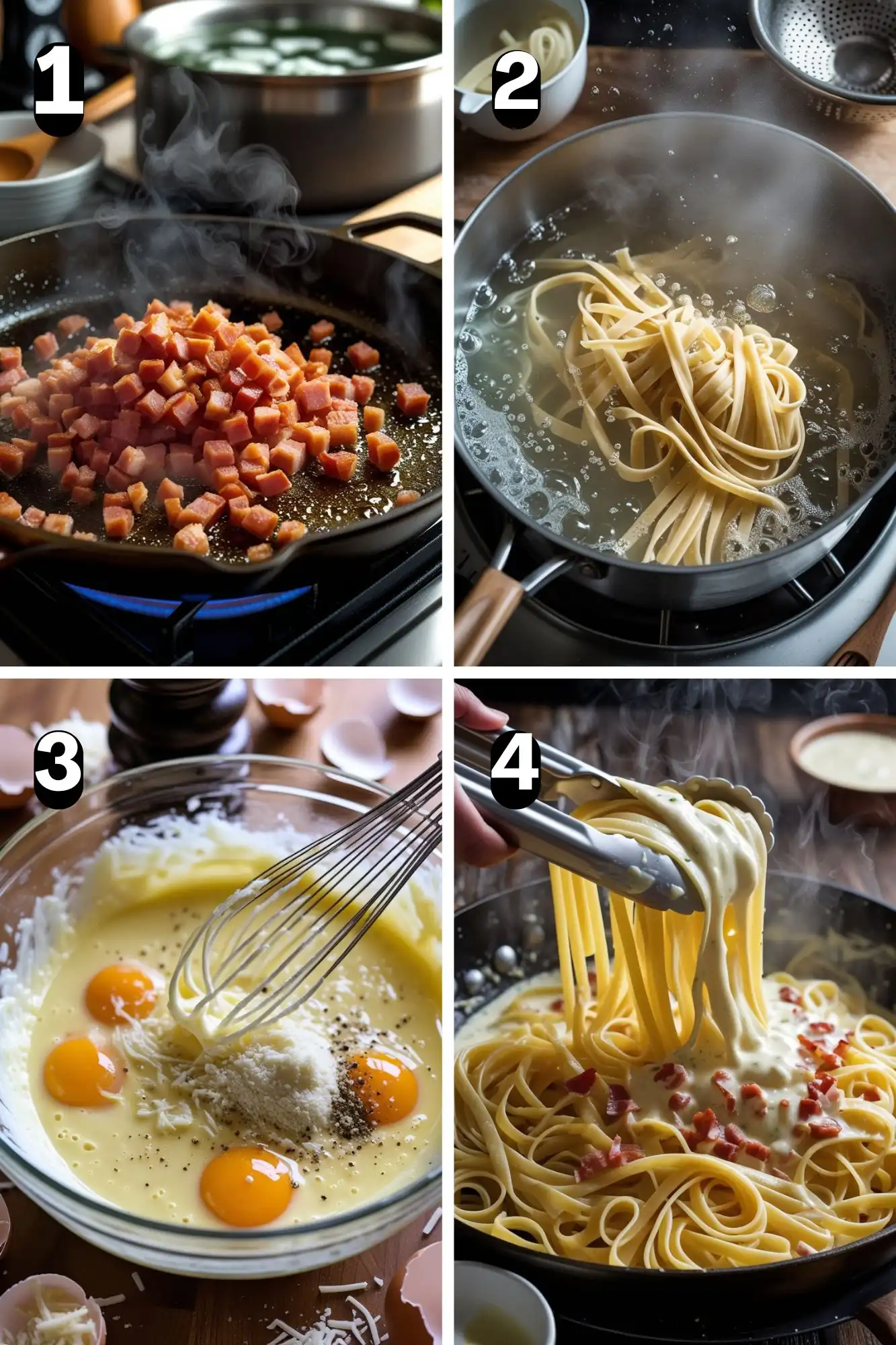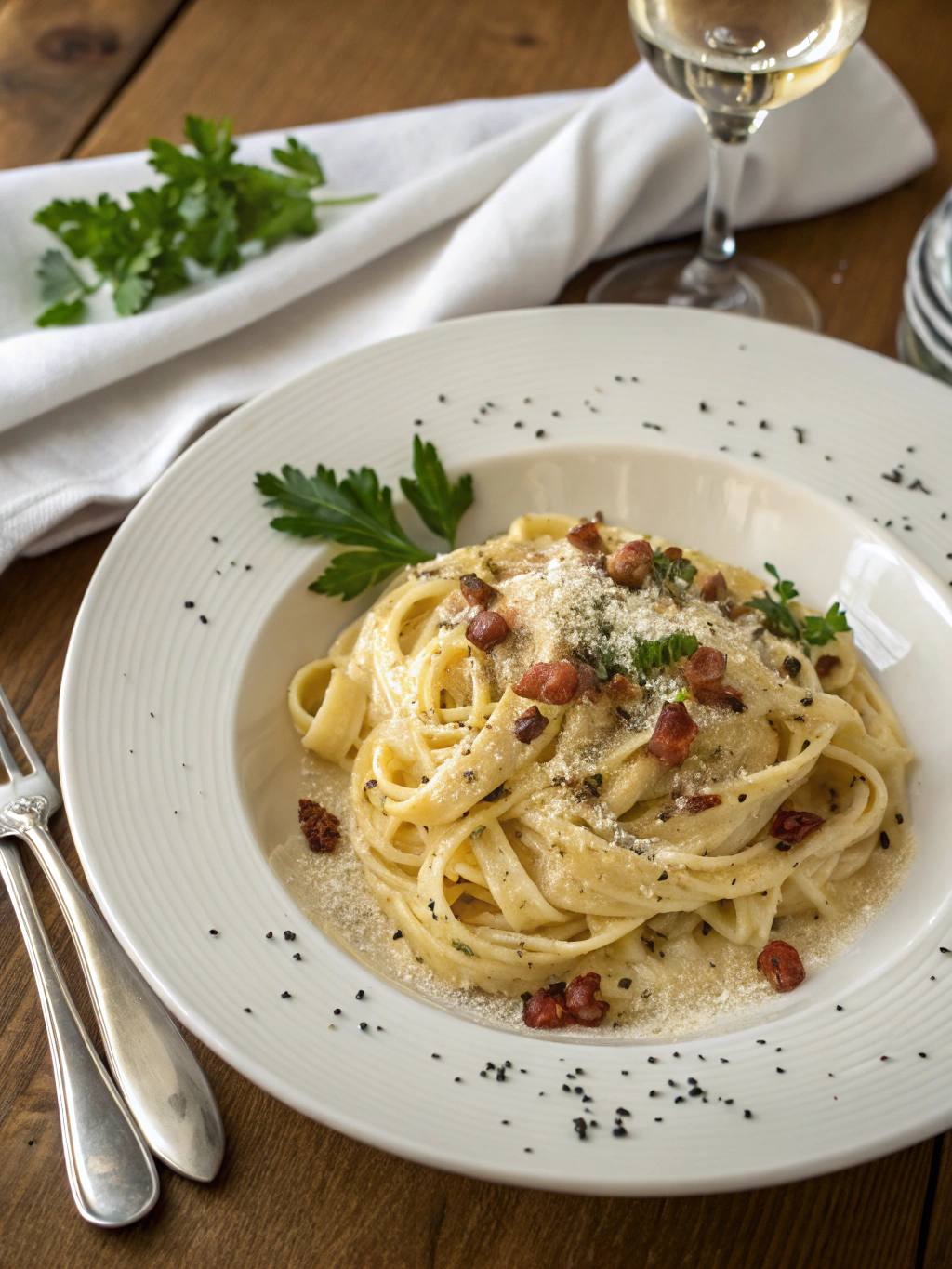How to Make Fettuccine Carbonara

Table of Contents
How to Make Fettuccine Carbonara – A Simple and Creamy Recipe
Do you ever wonder why the creamy, luscious carbonara you crave at your favorite Italian restaurant consistently eludes your grasp at home? Is it some secret ingredient, a complex technique, or just a fundamental misunderstanding of the dish’s simplicity?
The good news is that getting that perfect, authentic fettuccine carbonara is achievable, and I’m here to show you how with this simple, creamy recipe.
Enjoy the rich flavors of pancetta, egg, and cheese in every bite. Let’s dive into the art of carbonara and debunk the myth that it’s difficult, helping you master this iconic dish.
Ingredients List
Here’s what you’ll need to bring your homemade carbonara to life! Remember, the quality of your ingredients directly impacts the final dish.

- Fettuccine: One pound (about 16 ounces) of high-quality fettuccine pasta. Fresh pasta is a treat, but dried works wonderfully.
- Pancetta: 6 ounces, diced. Opt for thick-cut pancetta for extra flavor and a satisfying texture. (Alternatives: Guanciale (Traditional), or even bacon, which is a great option.)
- Eggs: 4 large, free-range eggs. Use the freshest eggs you can find for the best flavor.
- Parmigiano-Reggiano: 1 cup, grated. Freshly grated Parmigiano-Reggiano provides the best flavor and melts beautifully.
- Pecorino Romano: ¼ cup, grated. Adds a salty, sharp counterpoint to the richness of the dish. If you don’t have Pecorino, you can substitute with another ¼ cup of Parmigiano-Reggiano, but be mindful that the taste will change.
- Black Pepper (freshly ground): To taste. Freshly ground black pepper provides a delicious contrast.
- Salt: You’ll need salt for the pasta water.
Timing
Planning is everything! This recipe is surprisingly quick, perfect for a weeknight dinner.
- Prep Time: 5 minutes.
- Cook Time: 15 minutes.
- Total Time: 20 minutes. That’s right, in under 30 minutes, you can have a restaurant-quality meal on your table. Compared to a complex lasagna recipe, this is a time saver. (Data Source: Average lasagna recipe takes 90 minutes of total time).
Step-by-Step Instructions
Mastering carbonara is all about timing and technique. Follow these steps, and you’ll be well on your way to carbonara perfection.

Step 1: Prepare the Pancetta and Pasta Water
Heat up a large skillet over medium heat. Add the diced pancetta and cook, stirring occasionally, until it’s crispy and the fat is rendered – roughly 5-7 minutes. Remove the pancetta with a slotted spoon and set aside, leaving the rendered fat in the skillet. This fragrant fat is gold! While the pancetta cooks, bring a large pot of salted water to a rolling boil to cook fettuccine carbonara. The water should be as salty as the sea; that’s how you season the pasta from the inside out.
Step 2: Cook the Pasta
Add the fettuccine to the boiling water and cook according to package instructions, typically until al dente (firm to the bite). This will ensure the pasta is not overcooked when mixed.
Step 3: Create the Sauce
While the pasta is cooking, whisk the eggs in a bowl. Add ¾ cup of the grated Parmigiano-Reggiano and the Pecorino Romano, then season generously with freshly ground black pepper. Whisk thoroughly until you achieve a smooth, homogenous mixture.
Step 4: Combine and Toss
- Important: This step is key to the creamy texture. Drain the pasta, reserving about 1 cup of the pasta water. Immediately add the hot, drained pasta to the skillet with the rendered pancetta fat. Turn off the heat (this prevents the eggs from scrambling). Quickly pour the egg and cheese mixture over the pasta and toss vigorously, using tongs, to coat every strand. If the sauce seems too thick, add a splash of the reserved pasta water until it reaches your desired consistency. The hot pasta will cook the eggs without scrambling them, creating a velvety sauce.
- Pro Tip: To avoid clumping, work fast, and make sure the pasta is thoroughly coated with the sauce.
Step 5: Serve and Garnish
Immediately serve the carbonara. Top with the crispy pancetta, the remaining grated Parmigiano-Reggiano, and a generous sprinkle of fresh black pepper. Enjoy!
Add a touch of extra virgin olive oil for a more aromatic experience.
Nutritional Information
(Per serving, approximate values based on standard ingredient quantities – always check product labels for accuracy.) Note: Nutritional values may differ due to variances in ingredients.
- Calories: Roughly 600-750 calories.
- Protein: Approximately 30-35 grams.
- Fat: Around 40-50 grams (primarily from eggs, cheese, and pancetta).
- Carbohydrates: Approximately 40-50 grams.
- Fiber: Roughly 3-5 grams.
Data Sources: This is an estimated calculation. Consider the serving size and ingredient quantity when taking note of the information provided above.
Healthier Alternatives for the Recipe
Want to lighten things up without losing flavor? Here are some creative adjustments:
- Lighter Protein: Substitute the pancetta with turkey bacon or chicken breast for a leaner option.
- Lower-Fat Cheese: Use a reduced-fat Parmesan or part-skim mozzarella.
- Nutritional Boost: Add a handful of spinach or other leafy greens.
- Reduced Portion: Keep the portion size in check for healthier eating habits.
- Creative Substitution: Change the pasta to whole-wheat fettuccine for added fiber, to improve your nutritional intake.
Serving Suggestions
Carbonara is delicious on its own, but these serving suggestions will elevate your dining experience.

- Side Salad: Serve with a simple green salad with balsamic vinaigrette to cut through the richness.
- Garlic Bread: Crusty garlic bread is the perfect accompaniment.
- Wine Pairing: A crisp, acidic wine like Pinot Grigio or a dry Rosé complements the dish beautifully.
- Seasonal Elements: Vary the flavour with seasonal ingredients, adding truffles if in winter, or fresh basil in summer. The possibilities are endless!
- Customization: Adding sauteed mushrooms adds an extra layer to the recipe.
Common Mistakes to Avoid
Avoid these common pitfalls, and you’ll be well on your way to carbonara success.
- Overcooked Pasta: Nothing ruins carbonara faster than mushy pasta. Always cook al dente.
- Scrambled Eggs: The temperature is critical. Never add the egg mixture over direct heat; the pasta and the residual heat from the skillet are enough to cook the eggs.
- Insufficient Seasoning: Pasta water should be heavily salted, and season the egg mixture generously with pepper.
- Using Low-Quality Ingredients: Fresh, high quality ingredients is essential.
- Clumping Issues: Mix ingredients really quickly and properly.
Storing Tips for the Recipe
Proper storage will help your leftovers maintain their freshness and deliciousness.
- Refrigeration: Store leftover carbonara in an airtight container in the refrigerator for up to 2 days.
- Reheating: Reheat gently in a skillet over low heat, adding a splash of water or cream to loosen the sauce, as needed. Carbonara is best served fresh, but handled properly, the leftovers will still be great!
- Freezing Options: Freezing is not recommended, as the texture tends to change.
Conclusion
You’ve now mastered the art of making fettuccine carbonara! With this straightforward recipe, you can enjoy a simple, creamy dish in the comfort of your own home. Remember, it all boils down to quality ingredients, proper technique, and a dash of love.
Ready to impress? Grab your pasta, pancetta, and cheese, and get cooking! Don’t forget to share your creations and feedback in the comments below or on social media! We’d love to see your work!
FAQs
Got questions? Here are some frequently asked questions (FAQs):
- Can I use bacon instead of pancetta? Yes, bacon is a good substitute, though it will taste slightly different. Make sure to remove some of the excess fat.
- Can I freeze carbonara? It’s not recommended, as the sauce tends to separate and the pasta can become mushy.
- What if I don’t have Pecorino Romano? While authentic, it’s not a necessity for a tasty dish, substitute ¼ cup of Parmigiano-Reggiano and use that instead. The taste will lean more towards the Parmesan flavor.
- How do I prevent scrambled eggs? The key is to use the residual heat of the pasta and pan to cook the eggs. Turn off the heat before adding the egg mixture, and toss rapidly.
- What pasta shape is best? Fettuccine is traditional, but other long pasta shapes like spaghetti or bucatini also work well.
- Can I add cream to carbonara? Traditional carbonara does not include cream. The sauce should be created from the egg yolks and cheese. Adding cream can alter the intended classic taste.
Leave A Comment
Your email address will not be published. Required fields are marked *
There are no reviews yet. Be the first one to write one.
